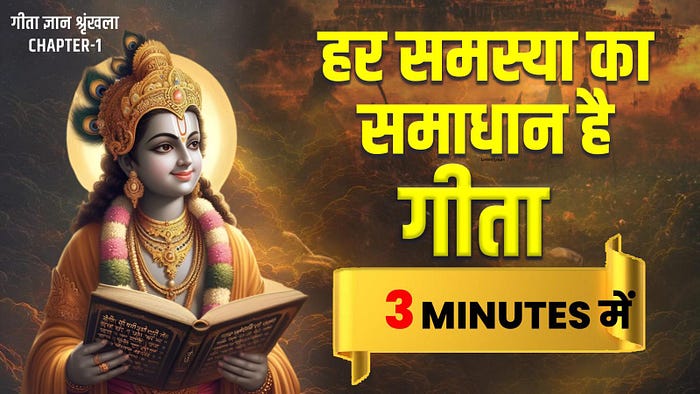What is the message of Chapter 1 of the Bhagavad Gita?
The Bhagavad Gita is one of the most profound spiritual texts in the world, guiding humanity through philosophy, ethics, and the eternal search for truth. Among its 18 chapters, the very first — Arjun Vishad Yoga (The Yoga of Arjuna’s Despair) — sets the stage for the entire dialogue between Lord Krishna and Arjuna on the battlefield of Kurukshetra.

In this article, we will explore the significance of this chapter, the dilemma faced by Arjuna, and the timeless lessons it offers to us in modern life.
The Battlefield of Kurukshetra
The Mahabharata describes a momentous war between the Pandavas and the Kauravas. As both armies gathered on the battlefield of Kurukshetra, warriors, kings, and sages prepared for a decisive clash that would change the course of history.
It was here that Arjuna, the mighty warrior of the Pandavas, stood ready to fight. But when he saw his own relatives, teachers, and friends on both sides, his courage faltered.
Arjuna’s Inner Conflict
The first chapter of the Gita describes Arjuna’s moral and emotional crisis. He felt torn between his duty (Dharma) as a warrior and his compassion for his loved ones. Arjuna’s words reflect deep sorrow and confusion:
- He questioned the value of victory gained by killing his own kin.
- He feared that the war would destroy family traditions and disrupt social order.
- He was overwhelmed with grief and put down his bow, refusing to fight.
This emotional breakdown is what we call Vishad (despair or dejection).
Why Krishna Remained Silent in Chapter 1
Interestingly, in this chapter, Krishna remains silent. He listens patiently to Arjuna’s doubts without interrupting. This shows us the importance of listening before guiding — a timeless lesson in leadership, mentorship, and relationships.
Only after Arjuna fully expresses his despair does Krishna begin his divine teaching in the second chapter.
Life Lessons from Arjun Vishad Yoga
Although the setting is a battlefield, the teachings resonate deeply with our daily struggles:
- Emotional honesty is the first step to clarity — Arjuna’s openness about his despair allows the dialogue with Krishna to begin.
- Every great journey starts with questions — Without doubt, there is no search for wisdom.
- Listening is powerful — Just as Krishna listened, we too must learn to listen before giving advice.
- Crisis can lead to transformation — Arjuna’s despair was not weakness, but the beginning of his spiritual awakening.
Why This Chapter Matters Today
In the modern world, many of us face dilemmas similar to Arjuna’s — whether in careers, relationships, or ethical choices. We may feel torn between duty and emotion, success and values, ambition and compassion.
Arjun Vishad Yoga teaches us that even despair has meaning. It is not the end, but the beginning of deeper understanding.
Watch the Full Video Explanation
For a detailed exploration of Arjun Vishad Yoga and its spiritual meaning, you can watch the full video here:
👉 Watch on YouTube
Final Thoughts
The Bhagavad Gita begins not with answers, but with questions. Arjuna’s despair becomes the foundation for one of the greatest spiritual conversations in history. This reminds us that our doubts, too, can become the starting point for wisdom — if we seek guidance and truth with an open heart.
What do you think about Arjuna’s dilemma? Do you relate to his conflict in your own life? Share your thoughts in the comments below.
Comments
Post a Comment